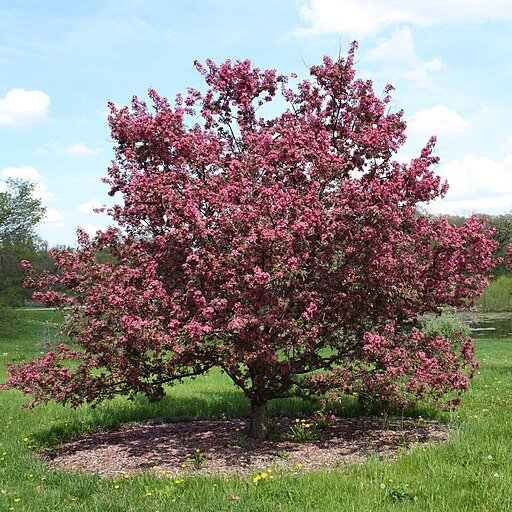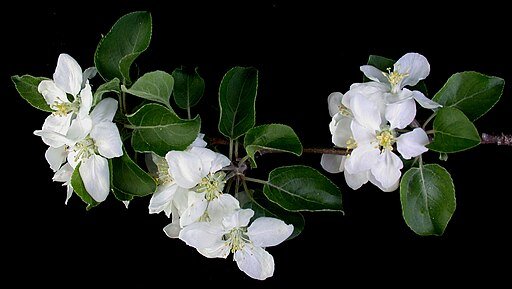The Crabapple
The history of the Crabapple, why some sidekicks are better than others, and which pocket is best to pick.
Malus ‘Centurion’, April 19
“Every thought is a seed. If you plant crab apples, don’t count on harvesting Golden Delicious.”
Should you decide, assuming you haven’t already, to embark on a career as a grifter, it would serve you well to learn a thing or two about pockets. Which pocket provides the highest returns, for example? Which will land you in the clink? As a fingersmith, you’ll need to refine a technique called fanning. This involves distracting your target: smiling, nodding, resting a hand on a shoulder here, lightly touching an elbow there. Eventually, you’ll let your fingertips graze a pocket or two, taking inventory, before choosing your mark and making the grab.
The most commonly picked pocket is the one just inside a man’s jacket, called the pit—assumedly a reference to its proximity to the axilla. Pytt is an old English word that has kept its meaning, a "natural or man-made depression in the ground,” for more than a millennia. Used in the anatomical sense, as in a natural hollow in some part of the body or other, it is more recent. The armpit, to which we refer here, is first known around the 14th century. The angst infused ‘pit of the stomach’ is from the 1650’s. Before that, it was called the ‘breast pit’ (late 14c) or originally’ heart pit’ (c. 1300). Why the bottom (or pit) of our heart has been escalated to a reservoir of love, while the pit of our stomach is reduced to the source of all dread, seems an unjust demotion for such a vital organ.
The pratfall and the prat pocket.
The second most common pocket is the prat, from the British slang for buttock, and is found in this location. Easier to get at, harder to extract Tack the word fall onto either pocket and you’ll get two entirely new words, pitfall and pratfall. A pitfall originally meant a hole into which a person or animal may stumble unawares, but gradually took on the more familiar gist of any hidden danger or concealed source of disaster. Similarly, a pratfall began as an informal word for falling on one’s backside, but now applies in a broader sense to any humiliating mishap.
This brings us, of course, to the least picked pocket of them all: the kick. The kick sits comfortably toward the front of the trousers making it a challenge to access unnoticed. Because of its proximity to the hand, it has long been considered the most unproductive for the plunderer. Conversely, the kick is the safest receptacle for the occupant and thus the pocket in which we bestow the greatest confidence. A sidekick, then, is the companion we keep at our side; the one we know and trust above all others.
Side kicks have been around a long time. The Epic of Gilgamesh, composed as a collection of Sumerian poems beginning around 2100 BC, tells of Enkidu, who evolved from a slave into the King’s closest confident. The Old Testament tells of Moses approaching Pharaoh with his sidekick Aaron to act as his voice and hands. According to Merriam Webster the word sidekick was first used as such in 1896, but does not specify how or in what context. Fictional narratives are rife with famous examples:
Samwise and Frodo
Goose and Maverick
Chewbacca and Han
Jesse Pinkman and Walter White
Gromit and Wallace
Rhodey and Iron Man
Ron Weasley and Harry Potter
It’s impossible over such a distance of time to concede the title of oldest known sidekick. But what could be more convincing than an ally who has been there since the beginning? One that has literally evolved with the other through time, stoking the embers of survival and fertilizing productivity? In my estimation, there is no finer example than apple’s humble sidekick: the crabapple.
Short in stature, big in color.
Malus is a genus of about 30–55 species of small deciduous trees and shrubs in the Rosaceae family, including the domesticated orchard apple (Malus domestica), wild apple, and the crab apples. (We learned about the domestica species and its champions, John Chapman and Jesse Hiatt, last week.) Modern scientists define crabapples by their small size — typically any tree that produces apples of less than two inches across. As a result, crabapples span a far broader scope of speciation than marketplace apples, but can be grouped and identified by their characteristic tartness (from a prolific production of malic acid), showy flowers, and short stature. The tallest on record, found in Brieselang Germany, is 70 feet tall, but the average adult crabapple measures only 15-20’, about the height of a one story house.
The fruit of the crabapple is small, often unsightly, and almost always bitter (the ‘Chestnut’ cultivar a notable exception). It is not an important production crop and is rarely eaten raw, but does provide a useful source of pectin, a gelling agent for jams and jellies. It can be simmered into a sour condiment, reportedly used in some southeast Asian cultures with salt, chili, and shrimp paste. The wood of most Malus species, when burned, produces a savory spice-like aroma and has been leveraged for centuries to cure and flavor meats. More recently the polyphenols and flavonoids that excite these pleasantries are being extracted to inhibit growth of E. coli and Staphylococcus.
Portrait of crabapple blossoms by Gilles Ayotte
The primary household use for the crabapple, however, is to enliven the residential landscape. Blossoms of the Malus sp. burst onto the scene in late spring like strawberry confetti. Some single, some double, and some in between (a so called and somewhat confusing ‘semi-double’), the blooms appear, charmingly salmon to light pink, toward then end of April here in Indiana and remain for 5-12 days. The scent varies considerably, with varieties like Malus coronaria and Malus ionensis producing robust apple, clove, and cinnamon notes and others such as Malus sargentii fulminating an odor that at least some describe as a “surprisingly assertive funk”.
More curiously, crabapples are widely harnessed to support the commercial apple trade. The rootstocks of Malus bachata, for example, give domestic apples additional cold hardiness, effectively expanding northward their resilience and utility. Crabapples tend to render more pollen and are therefore planted within apple orchards or grafted onto existing stock to enrich the corbiculae (pollen baskets) of peckish bees. If that’s not enough or in the case of phenological emergencies, a bucket of flowering crabapple branches is placed near beehives to fast track orchard pollination.
It is worth pausing here to note that the role of the sidekick can be defined broadly. Some provide comic relief, say, as in Donkey and Shrek, or conversely serve as straight-man, such as Sancho Panza to Don Quixote. A sidekick may simply know the hero better than others and foster a sense of emotional connection (Watson and Sherlock). But the best go beyond this. A sidekick should synergize with the hero’s skillset, foster growth and prosperity, be present when needed. If you want a really great sidekick, look for one that can do things you can’t, one that is willing to make you look good, and one that gives the world convincing evidence to like you. If you want to find your best sidekick, find your crabapple.
Basics
Common Name: flowering crabapple
Type: tree
Family: Rosaceae
Zone: 4 to 8
Height: 15 to 20 feet
Spread: 15 to 20 feet
Bloom Time: April to May
Bloom Description: White to Deep Pink
Sun: Full sun
Water: Medium
Maintenance: Low
Suggested Use: Flowering Tree
Flower: Showy
Knowledge Sources
https://extension.colostate.edu/topic-areas/yard-garden/flowering-crabapple-trees-7-424/
https://www.merriam-webster.com/dictionary/sidekick
http://www.word-detective.com/122099.html
https://theshakespeareblog.com/2015/07/bidford-on-avon-and-the-shakespeare-legend/
https://archive.org/details/shakespearescrab00greeuoft/page/46/mode/2up?view=theater
https://eatthetable.com/2020/05/30/crab-apples/
https://money.howstuffworks.com/pickpocket.htm
https://en.wikipedia.org/wiki/Pickpocketing
https://spyscape.com/article/the-sneaky-pickpocketing-glossary
https://www.etymonline.com/search?q=pit&utm_campaign=sd&utm_medium=serp&utm_source=ds_search
https://etcsl.orinst.ox.ac.uk/section1/tr1813.htm
https://www.morphsuits.co.uk/blog/the-most-iconic-sidekicks-in-history/
https://www.monumentaltrees.com/en/trees/malussylvestris/records/
https://en.wikipedia.org/wiki/Pectin
https://web.archive.org/web/20071011022757/www.the-tree.org.uk/
https://lirias.kuleuven.be/2379496?limo=0
Image Sources
https://commons.wikimedia.org/wiki/File:Policemen_apprehend_a_pickpocket_taking_a_license_from_a_pub_Wellcome_V0019439.jpg
https://commons.wikimedia.org/wiki/File:S._Holmes_and_Watson_in_Watson%27s_consulting_room_Wellcome_L0015282.jpg
https://commons.wikimedia.org/wiki/File:Purple_prince_crabapple_tree.JPG
https://commons.wikimedia.org/wiki/File:Malus_sp._15-p.bot-malus.sp-31.jpg





